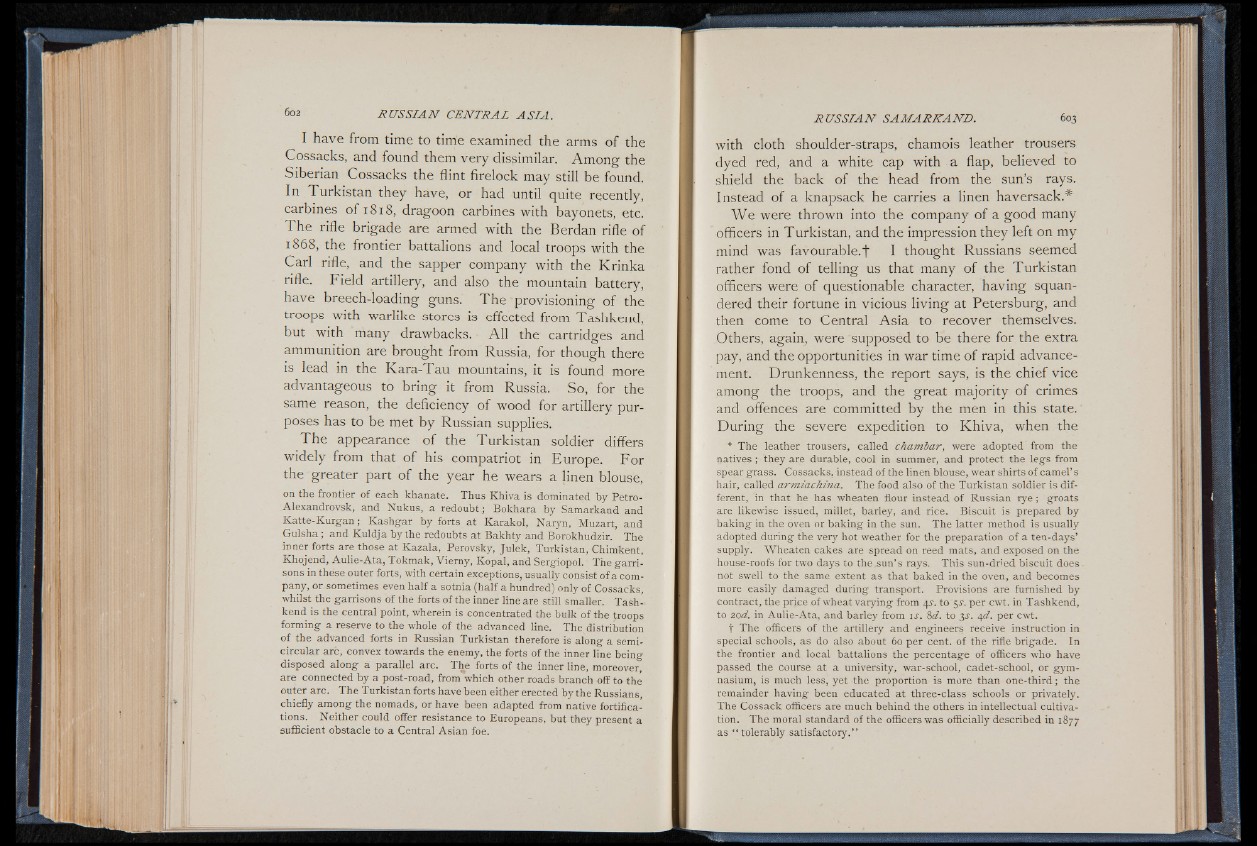
I have from time to time examined the arms of the
Cossacks, and found them very dissimilar. Among the
Siberian Cossacks the flint firelock may still be found.
In Turkistan they have, or had until quite recently,
carbines of 1818, dragoon carbines with bayonets, etc.
The rifle brigade are armed with the Berdan rifle of
1868, the frontier battalions and local troops with the
Carl rifle, and the sapper company with the Krinka
rifle. Field artillery, and also the mountain battery,
have breech-loading guns. The provisioning of the
troops with warlike stores is effected from Tashkend,
but with many drawbacks. All the cartridges and
ammunition are brought from Russia, for though there
is lead in the Kara-Tau mountains, it is found more
advantageous to bring it from Russia. So, for the
same reason, the deficiency of wood for artillery purposes
has to be met by Russian supplies.
The appearance of the Turkistan soldier differs
widely from that of his compatriot in Europe. For
the greater part of the year he wears a linen blouse,
on the frontier of each khanate. Thus Khiva is dominated by Petro-
Alexandrovsk, and Nukus, a redoubt ; Bokhara by Samarkand and
Katte-Kurgan ; Kashgar by forts at Karakol, Naryn, Muzart, and
Gulsha ; and Kuldja by the redoubts at Bakhty and Borokhudzir. The
inner forts are those at Kazala, Perovsky, Julek, Turkistan, Chimkent,
Khojend, Aulie-Ata, Tokmak, Viemy, Kopal, and Sergiopol. The garrisons
in these outer forts, with certain exceptions, usually consist of a company,
or-sometimes even half a sotnia (half a hundred) only of Cossacks,
whilst the garrisons of the forts of the inner line are still smaller. Tashkend
is the central point, wherein is concentrated the bulk of the troops
forming a reserve to the whole of the advanced line. The distribution
of the advanced forts in Russian Turkistan therefore is along a semicircular
arc, convex towards the enemy, the forts of the inner line being
disposed along a parallel arc. The forts of the inner line, moreover,
are connected by a post-road, from which other roads branch off to thé
outer arc. The Turkistan forts have been either erected by the Russians,
chiefly among the nomads, or have been adapted from native fortifications.
Neither could offer resistance to Europeans, but they present a
sufficient obstacle to a Central Asian foe.
with cloth shoulder-straps, chamois leather trousers
dyed red, and a white cap with a flap, believed to
shield the back of the' head from the sun’s rays.
Instead of a knapsack he carries a linen haversack.*
We were thrown into the company of a good many
officers in Turkistan, and the impression they left on my
mind was favourable.")* I thought Russians seemed
rather fond of telling us that many of the Turkistan
officers were of questionable character, having squandered
their fortune in vicious living at Petersburg, and
then come to Central Asia to recover themselves.
Others, again, were supposed to be there for the extra
pay, and the opportunities in war time of rapid advancement.
Drunkenness, the report says, is the chief vice
among the troops, and the great majority of crimes
and offences are committed by the men in this state.
During the severe expedition to Khiva, when the
* The leather trousers, called chambar, were adopted from the
natives ; they are durable, cool in summer, and protect the legs from
spear g rass. Cossacks, instead of the linen blouse, wear shirts of camel’ s
hair, called armiachina. The food also of the Turkistan soldier is different,
in that he has wheaten flour instead of Russian r y e ; groats
are likewise issued, millet, barley, and rice. Biscuit is prepared by
baking in the oven or baking in the sun. The latter method is usually
adopted during the very hot weather for the preparation of a ten-days’
supply. Wheaten cakes are spread on reed mats, and exposed on the
house-roofs for two days to the .sun’ s rays. This sun-dried biscuit does
not swell to the same extent as that baked in the oven, and becomes
more easily damaged during transport. Provisions are furnished by
contract, the price o f wheat varying from 4.?. to 5V. per cwt. in Tashkend,
to 20d. in Aulie-Ata, and barley from i j . 8d. to 3J. \d. per cwt.
t The officers of the artillery and engineers receive instruction in
special schools, as do also about 60 per cent, of the rifle brigade. In
the frontier and local battalions the percentage of officers who have
passed the course at a university, war-school, cadet-school, or gymnasium,
is much less, yet the proportion is more than one-third; the
remainder having been educated at three-class schools or privately.
The Cossack officers are much behind the others in intellectual cultivation.
The moral standard of the officers was officially described in 1877
as “ tolerably satisfactory.”